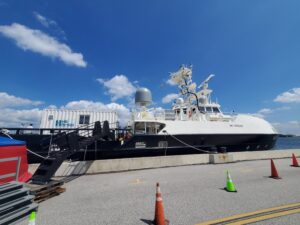A Navy office is conducting market research to find if industrial options exist for a future requirement of a 10-vessel class of expendable unmanned vehicles mother ships, called Attritable UxV Mother Ship (AUMS).
The Unmanned Maritime Systems Program Office (PMS 406) within Program Executive Office (PEO) Unmanned and Small Combatants issued the sources sought/request for information (RFI) on Oct. 31. The notice said AUMS is a “potential solution to cost-effectively delivering large numbers of UxVs to forward locations in a contested environment.”
UxVs covers unmanned air, ground, surface and subsurface vehicles, so the AUMS would be an unmanned vessel delivering a group of other unmanned vehicles that could cover any of those types.

The RFI emphasized it aims to minimize cost as much as possible, so the system is actually attritable.
Therefore, the Navy said it wants the minimum service life of the AUMS to be five years, but higher is preferable “if attainable for a very small increase in procurement cost.”
AUMS is expected to at least include modular open system approaches so it can quickly incorporate new technology in a mid-life upgrade, transit around 1,500 nautical miles on the open ocean; have a top speed of 12 to 20 knots; able to operate in a fully unmanned state for up to five days while underway and conducting its mission over the horizon from Navy assets; cover a notional class of 10 AUMSs; and able to support a 20-foot ISO shipping container onboard or via a towed body, whichever is cheaper.
If the container is carried onboard, the solicitation said there must be a capability to push it over the side of the vessel because upon reaching a set drop-off location, the container filled with UxVs must be self-sustaining, deployed, and left alone. The AUMS is not meant to loiter where it deploys the UxVs.
The Navy wants the AUMS to be unmanned and able to follow waypoints and navigating through GPS, but account for a lack of GPS with a focus on the cost to navigate without it vs. navigational drift.
Industry concepts for the vessels are also directed to consider Over The Horizon (OTH) and Line Of Sight (LOS) communications “as a means of providing basic tasking to the platform and maintaining situational awareness of the platform.”
The notice said AUMS should also be designed to minimize the chance it collides with other vessels or minimize damage to those vessels and responses should talk about the trade space of how this can be achieved. However, the Navy said AUMS will only travel across open ocean/blue water and “will never be < 3 nm to any shoreline untended.”
Therefore, the Navy told industry to assume AUMS can be towed or remotely driven into position in the open ocean.
The notice said the Navy aims to use a collaborative approach with industry to produce a low cost AUMS and outlined a potential timeline.
Under this concept, the Navy may award a design and construction contract for AUMS by mid-fiscal year 2026 and concepts are directed to consider all affordability options needed to quickly deliver the first vessel within 24 months, if possible.
“Navy is looking for the most efficacious approach with industry to rapidly deliver this capability to include leveraging existing commercial, manned or unmanned surface ship designs that can be re-designed and/or modified. A clean slate design will be considered if it can be demonstrated to be the most beneficial to the Navy,” to RFI said.
The notice said the Navy also wants to hear industry’s recommendations on the overall approach to this potential AUMS program, which could include one or more vessel prototypes that can be operationally employed after initial testing, a traditional program of record, or a unique non-traditional approach.
“If the recommendation is for an approach that begins with prototypes, request a recommendation of how many such prototypes are required before beginning a production run with a baseline design.”
However, the notice emphasized that “cost containment is the single most important goal of the AUMS design and approach. The Navy envisions starting with a vessel that is built or designed to commercial classification standards and adding military-unique specifications only where necessary to support the payload, command and control requirements, and concept of operations.”
The service said Navy Command, Control, Communications, Computers, and Intelligence (C4I) systems will be on the AUMS and provided as government furnished equipment, including line of sight and beyond line of sight communications. The modularized 20-foot ISO container filled with UxVs will also be provided by the government.
The notice said this RFI seeks to assess industry’s ability to provide a materiel solution “within an accelerated timeframe at an affordable cost…interested in technical, administrative, and business risks in pursuit of the desired solution.”
The Navy said it wants responses to the RFI to include ship concept description and characteristics; cost drivers with recommended mitigations or innovative approaches; cost and schedule estimates; currently designed or fielded vessels capable of being a basis of the AUMS design; mature systems or subsystems able to meet AUMS needs; how available are existing vessels to be potential repurposed for the mission; and the time frame for design, conversion of any existing vessels, and various costs related to trade space decisions like changing the vessels’ speed, endurance or production schedule.
Responses are due by Dec. 15.
The Navy noted Booz Allen Hamilton [BAH] and the Johns Hopkins University – Applied Physics Laboratory may help the government review responses.